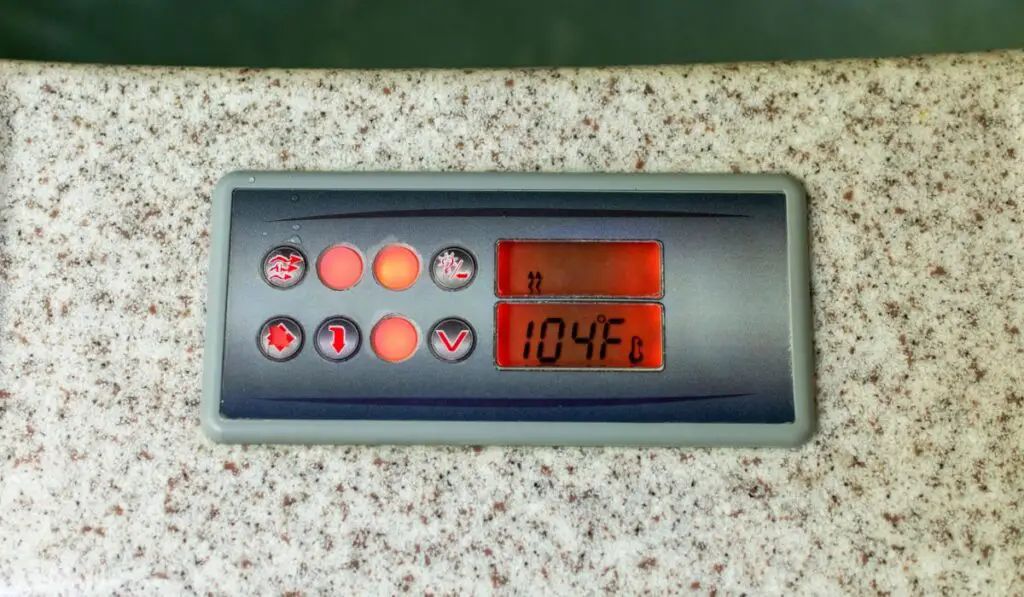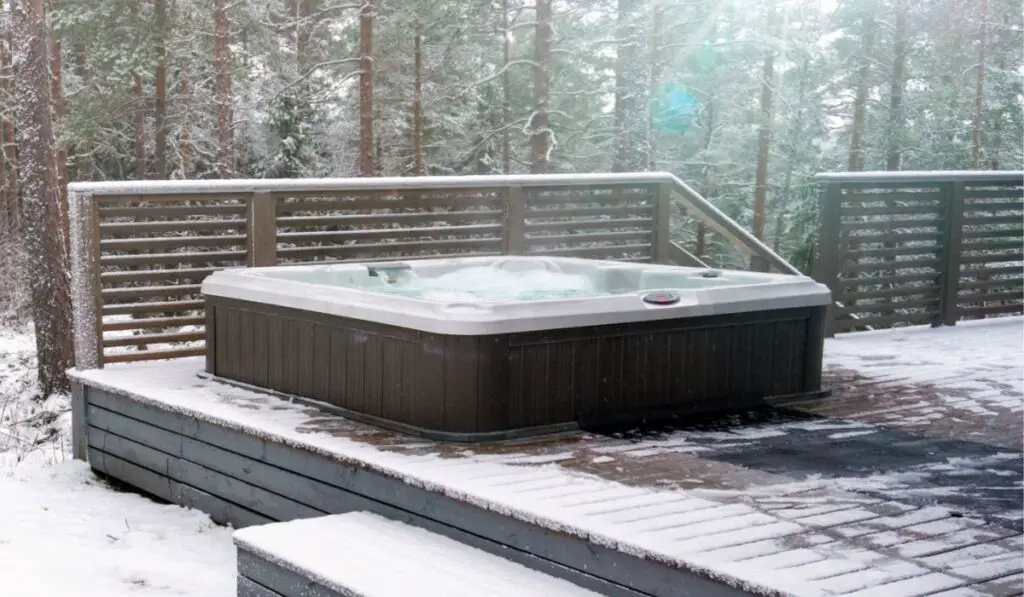Nothing beats the relaxing feeling of winding down in your hot tub, especially in the winter when you can’t seem to warm up. However, there are temperature-related safety warnings you want to watch out for. Here’s what to know about setting your hot tub’s temperatures:
Keep your hot tub’s temperatures within the safe and comfortable range of 100 to 102℉ during the winter. During the summer, keep the tub cooler at around 96℉. If you must turn down the temperature when not using the tub, keep it five ℉ below your preferred soaking temperature.
While you may want to crank the heater a little harder during winter, ensure the water temperature doesn’t exceed 104℉, the highest hot tub temperature the CDC recommends. Let’s get started so you figure out everything in detail.
What Temperature Should Your Hot Tub be When Not in Use?

When your hot tub is not in use, it’s better to maintain a soaking temperature of around 100℉ rather than turning it down by 10 or 20 degrees and having to reheat it again. It’s cheaper to maintain a higher temperature than reheat to get to the same threshold.
Understandably, it’s essential to conserve energy in your house in all possible ways, and extending that to your hot tub is no exception. However, while it may sound like common sense to lower the temperature every time you’re not using the tub, it doesn’t reduce your energy costs.
The best thing to do is find an ideal temperature and keep the water consistently there. This saves you the energy it would take to crank up the heater to get the water to your preferred temperature.
It also saves you time, as it usually takes time to heat the water to your desired soaking temperature. Remember, modern hot tubs can raise the water temperature by three to ten ℉ per hour, meaning it could take a couple of hours to get to 100℉ or 102℉, which most people prefer.
The heating time goes with the size of your hot tub, the insulation quality, and your heater’s efficiency.
The 5-Degree Rule
If you must turn down the temperature for whatever reason, you might want to observe the 5-degree rule. This ensures you keep the water temperature within 5° of the optimal soaking temperature.
So, if you usually find it comfortable to take a dip when the water is 102℉, turn it down to 97℉. And if you usually soak at 100℉, tweak it to 95℉ when not using the tub.
If you prefer to use your tub for less than three hours in cumulative time per week, you can apply the 5° rule. Otherwise, setting the water temperature lower will force your heater to work harder for longer, inflating your energy costs.
Even if you aren’t using your hot tub over the winter, say when you’re on vacation, you should keep the water warm enough at 95℉. It’s the only sure way you’ll prevent damage to the equipment and plumbing due to freezing.
If you stay away for more than three months over the winter, you might want to drain and winterize the hot tub. You can hire a professional for the job or do it yourself by following the proper steps.
Winter vs. Summer Temperatures
You can tweak your hot tub’s temperature settings depending on the season. However, you must operate within a safe and comfortable temperature range and not exceed 104℉.
Winter
In a practical sense, the exact temperature you set your hot tub is all a matter of preference.
So, during the winter, when it’s almost freezing to death, most hot tub owners feel comfortable keeping the water temperature between 102 and 104℉.
You can even stick with 100℉, as it’s still comfortable and safe for a healthy adult, as your body temperature is usually around 98.6℉. However, you might want to soak at different temperatures within the safe range to see what resonates well with you.
Summer
The temperatures you set in the summer will often be lower because that’s when you want to cool off. While most heater settings can go as low as 80℉, you can maintain a good range of 85 to 96℉.
This is noticeably cooler than your average body temperature of 98.6℉, and it’s safe and comfortable.
In addition, since most tubs feature an economy mode, you can maintain the water at around 80 to 85℉ when you’re not using the tub.
Risks of Too-High Water Temperatures
However, you can’t set a higher temperature than 104℉; the highest recommended hot tub temperature according to CDC guidelines and the Consumer Product Safety Commission (CPSC).
Even if, for some reason, your hot tub model can go beyond this threshold, you shouldn’t set a higher temperature. A tub that is too hot turns out to be dangerous.
First, it could make you feel light-headed or nauseous, quickly leading to fainting and drowning. And if you expose your body to temperatures of 110℉ and above for too long, you can suffer a heat stroke and die.
Depending on your health condition, your doctor may also recommend certain temperatures or maximum durations for which you can take a safe dip in your hot tub. Generally, the following people should avoid high temperatures in a hot tub:
- Children under five years of age.
- Pregnant women, as it could harm the fetus.
- People with heart complications or high blood pressure.
Heating Your Tub During the Winter vs. Summer: The Cost Difference

During the summer, you don’t usually set high temperatures in your hot tub, meaning the heater doesn’t work much, and you can incur fewer energy costs.
Those leisurely warm soaks are more enjoyable in the winter, but keeping the water temperature higher takes more energy. Remember, the cold air in the surrounding is in contact with the water, making it lose heat fast.
As a result, your hot tub’s heater has to work a little extra to keep the water temperature constant. This quickly translates into slightly higher energy costs.
That said, hot tub engineers and designers usually take important steps to keep tub operation costs minimum.
High-Quality vs. Low-Quality
The cost of operating and maintaining your tub in the winter depends on factors like the use of covers and the quality of insulation.
A well-designed, high-quality tub regularly maintained can stand up against the harshest winter with very little increase in energy costs. As such, you can expect to part with $15 to $20 monthly in operation costs during the winter.
High-quality hot tubs have thick, durable, insulating covers to avoid straining your heater. These create an efficient barrier between the surrounding cold air and the warm water, preventing heat loss.
They also maintain an air-tight seal around the edges of the hot tub to prevent the heat from leaking out. A well-built tub also comes with a densely-insulated base pan to lower your energy costs in the winter.
On the other hand, low-end tubs without the necessary features to keep out the cold can cause significant spikes in your energy bills during the winter. They could eat up as much as $50 per month to operate during the winter.
Important Maintenance Tips
Besides regulating your hot tub’s temperatures, you can follow these additional maintenance tips to reduce the costs of operating it, keep it safe, and make it last longer:
- Add a thermal blanket to improve insulation.
- Use a thick, high-quality cover that fits snugly.
- Keep the tub clean at all times.
- Observe limits like the maximum number of allowed bathers.
- Turn down the temperature by 5 degrees when not using the tub.
- Shock the tub to prevent algae from growing and making it sticky or slippery.
- Check to ensure equipment like filters and pumps are working correctly. For example, it’s likely clogged if the pump makes a strange noise while running.
- Balance the water properly and test to ensure the chlorine level is within 3 to 8 ppm, with a pH of 7.2 to 7.6.
